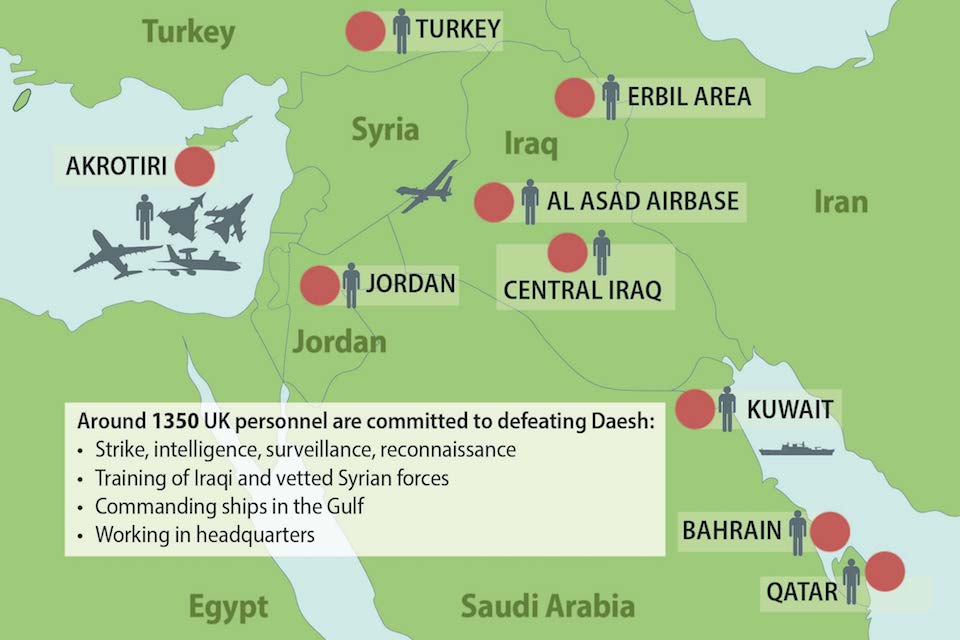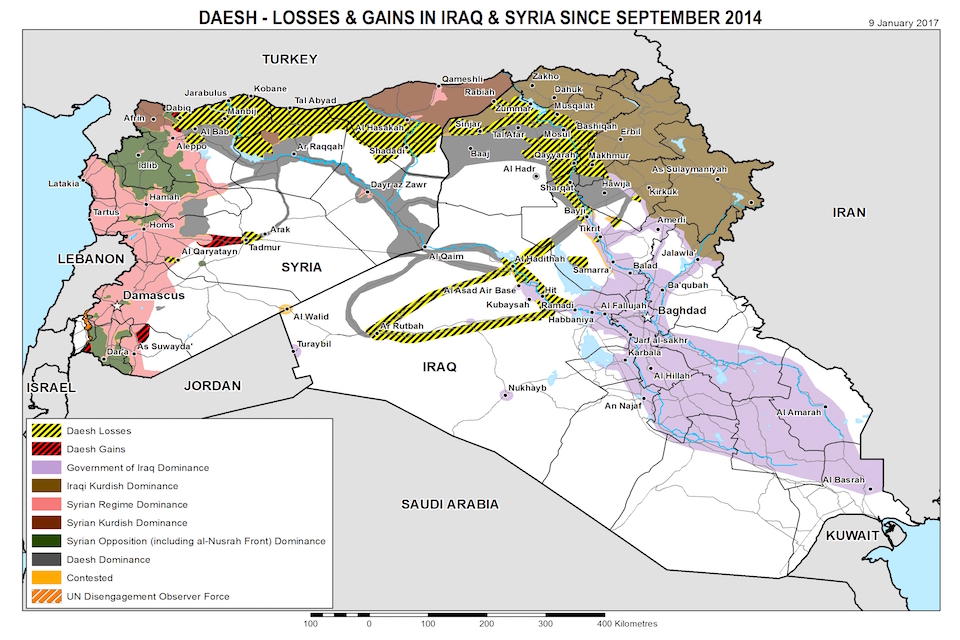The RAF are continuing to take the fight to Daesh in Syria.
The UK continues to demonstrate its world-leading air capability in the campaign against Daesh’s last major territory, Hajin, with 10 successful air strikes in 19 days over the Christmas period.
A combination of Typhoon and Tornado jets, as well as Reaper drones, supported Syrian Democratic Forces on the ground, as Daesh continue to be pushed underground.
British aircraft have also been lending assistance to the Iraqi security forces, to prevent the terrorists from regaining a foothold within the country.
Summary
- Monday 7 January – Tornados collapsed the entrance to a cave in northern Iraq, where Daesh had stockpiled equipment.
- Wednesday 9 January – Typhoons attacked three terrorist-held buildings in eastern Syria, north-east of Abu Kamal, while Tornados destroyed a truck-bomb facility.
- Thursday 10 January – a Reaper conducted two attacks on terrorists north-east of Abu Kamal, whilst Typhoons struck a further three Daesh-held buildings.
- Saturday 12 January – Tornados struck three Daesh tunnels to the south-west of Mosul.
- Sunday 13 January – Tornados destroyed a truck-bomb facility north-east of Abu Kamal, and cratered a nearby road to prevent any other truck-bombs from being moved into the area.
- Wednesday 16 January – Tornados destroyed a further truck-bomb facility and again cratered a road north-east of Abu Kamal, whilst Typhoons struck a Daesh-held building.
- Thursday 17 January – Typhoons and Tornados attacked eight Daesh positions north-east of Abu Kamal in support of the Syrian Democratic Forces.
- Friday 18 January – Typhoons bombed a building from which terrorists were firing at the Syrian Democratic Forces, north-east of Abu Kamal.
- Saturday 19 January – Tornados and Typhoons destroyed a strong-point and a sniper position north-east of Abu Kamal.
- Thursday 24 January – Tornados and Typhoons supported continuing SDF operations north-east of Abu Kamal, striking seven Daesh positions.
- Friday 25 January – Tornados and Typhoons attacked two further terrorist-held buildings north-east of Abu Kamal.
- Saturday 26 January – Tornados bombed five Daesh positions north-east of Abu Kamal.
Detail
Coalition aircraft remain available to assist the Iraqi security forces in their operations to prevent Daesh re-establishing any foothold in the country. An important part of this work is the ability to destroy terrorist stockpiles of weapons and other equipment concealed in remote areas of the countryside. On Monday 7 January, two RAF Tornado GR4s delivered an attack with a pair of Paveway IV guided bombs which successfully collapsed the entrance to a cave, fifty-five miles south-east of Kirkuk, where one such stockpile was known to be stored.
In Syria, our aircraft have continued to provide close air support to the Syrian Democratic Forces as they clear the ever-diminishing pocket of Daesh territory south of Hajin and north of Abu Kamal. Typhoon FGR4s, armed with Paveway IVs, attacked three buildings six miles north-east of Abu Kamal on Wednesday 9 January; Daesh fighters in the buildings were engaged in a close-quarters firefight with the advancing SDF. A pair of Tornados meanwhile used two Paveway IVs to deal with a truck-bomb facility in the same area. The following day, Typhoons struck a further three buildings, again being used as strong-points by Daesh. A Reaper was also patrolling the area, and its crew conducted two successful engagements with Hellfire missiles on Daesh terrorists, including a pair spotted setting up a firing position on a rooftop.
Tornados gave further assistance to the Iraqi security forces on Saturday 12 January, when they were asked to demolish the entrances to a set of tunnels discovered in the countryside to the south-west of Mosul. Each of the three entrances was successfully struck with a Paveway IV. On Sunday 13 January, Tornados were tasked with the destruction of a building five miles north-east of Abu Kamal where Daesh were known to be storing truck-bombs. The building and its contents was destroyed with a single Paveway; the Tornados then bombed a chokepoint on the nearby main road to prevent Daesh from moving any more truck-bombs into the area.
Tornados delivered similar attacks on Wednesday 16 January, bombing a further truck-bomb facility to the north-east of Abu Kamal, then cratering in two places a road leading towards the SDF locations. One of the Paveways used to crater the road caused a secondary explosion, an indication that Daesh had probably planted a booby-trap at that location. Typhoons also flew support for the SDF, striking a Daesh-held building. On Thursday 17 January, Typhoons attacked through cloud two Daesh positions which the SDF had under close observation – they confirmed both targets had been hit accurately – whilst Tornados bombed six more terrorist strong-points and firing positions.
The SDF encountered a Daesh-held building as they continued their advance on Friday 18 January, and found themselves under heavy fire. Two Typhoons were tasked to assist them, and a single Paveway IV removed the threat with a direct hit on the target. The following day, both Typhoons and Tornados flew close air support for the SDF, and delivered two attacks, striking a terrorist strong-point and eliminating a sniper position.
Two Tornados and two Typhoons provided further assistance to the SDF on Thursday 24 January, as they attacked a Daesh-held area on the eastern bank of the Euphrates, a few miles to the north-east and east of Abu Kamal. The Typhoons hit a group of terrorists fighting in the open, as well as two strong-points from which fire was being directed at the SDF, whilst the Tornados hit four such positions. All of these successful attacks used Paveway IV guided bombs. On Friday 25 January, Typhoon and Tornado flights each accounted for a further Daesh-held building, and on Saturday 26 January, a pair of Tornados struck five positions, all of which had been used by terrorists engaged in firefights with the SDF.
Royal Air Force aircraft have since continued flying armed reconnaissance patrols, on hand to support the SDF if required. Thursday 31 January saw the last operational sorties by Tornado GR4s – a pair flew an uneventful patrol over Syria, recovering safely to RAF Akrotiri at 1400 GMT after a mission lasting 6½ hours.
UK contribution to the fight against Daesh

Campaign against Daesh

Previous update
Royal Air Force aircraft have continued to fly daily armed reconnaissance missions over eastern Syria in support of the Syrian Democratic Forces offensive against Daesh around Hajin, as well as lending assistance when requested by the Iraqi security forces to prevent the terrorists from regaining a foothold within the country.
With the SDF pushing south-east from Hajin, Tornado GR4s provided close air support on Wednesday 19 December. The SDF encountered a truck-bomb concealed inside a building, and took cover whilst the Tornados dealt with the threat. A single Paveway IV guided bomb, on target, allowed them to continue their advance. Further support was rendered on Friday 21 December by a Reaper and another flight of Tornados. The Reaper’s crew successfully used a Hellfire missile against a small group of Daesh as they moved across country, whilst the Tornados destroyed two workshops which were producing improvised explosive devices. The following day, a Reaper spotted terrorists manning a heavy weapon and engaged them with a Hellfire which scored a direct hit. The Reaper then provided surveillance support to a coalition air strike on a Daesh-held building nearby. Tornados were also active south-east of Hajin, conducting Paveway IV attacks which destroyed a heavy machine-gun position and two other Daesh strong-points.
Further targets were identified on Monday 24 December, when Tornados, as ever supported by a Voyager air refuelling tanker, bombed two terrorist-held buildings in the path of the SDF advance. With Daesh continuing to lose ground, it was necessary to prevent them moving men and equipment, most particularly their favoured truck-bombs, along a road towards the SDF; a pair of Typhoons cratered the road with Paveway IVs on Wednesday 26 December. The Typhoons then joined a Tornado flight in destroying three Daesh-occupied buildings: the Typhoons dealt with one target, the Tornados struck the other two. The Tornados remained on station to provide further assistance if required by the SDF, and subsequently attacked a further two buildings from which the terrorists were firing. On Thursday 27 December, Typhoons bombed two more buildings held by Daesh, whilst Tornados hit a third.
Coalition aircraft remain available to support the Iraqi security forces as and when required, to ensure Iraq remains free of Daesh. Intelligence established that a terrorist stockpile of weapons was concealed deep in the western deserts of Anbar province, and two Tornados were tasked with its destruction on Friday 28 December. This was accomplished using a pair of Paveway IVs. A number of terrorists were meanwhile tracked to tunnels hidden beneath an extensive palm grove some twenty miles north of Baghdad; Typhoons carried out a successful attack, again with two Paveway IVs, against the tunnels and the terrorists within.
Operations continued south-east of Hajin on New Year’s Day, with a Reaper providing overwatch for the SDF. Surveillance support was given to a coalition air strike on a Daesh strong-point, and the Reaper’s crew then tracked terrorists as they attempted to take up new positions, engaging them with a Hellfire missile. With the SDF pushing further to the south and east of Hajin, along the road to Abu Kamal, a Reaper again flew overwatch for them on Sunday 6 January. The Reaper tracked a Daesh group to a compound some miles north of Abu Kamal, and provided targeting support to coalition fast jets as they subsequently delivered an attack. Two terrorists attempted to take up a new position after the compound was bombed, but were successfully engaged by the Reaper, using a Hellfire missile.
Details of previous airstrikes can be found here.
For more information see Daesh: UK government response page on GOV.UK







